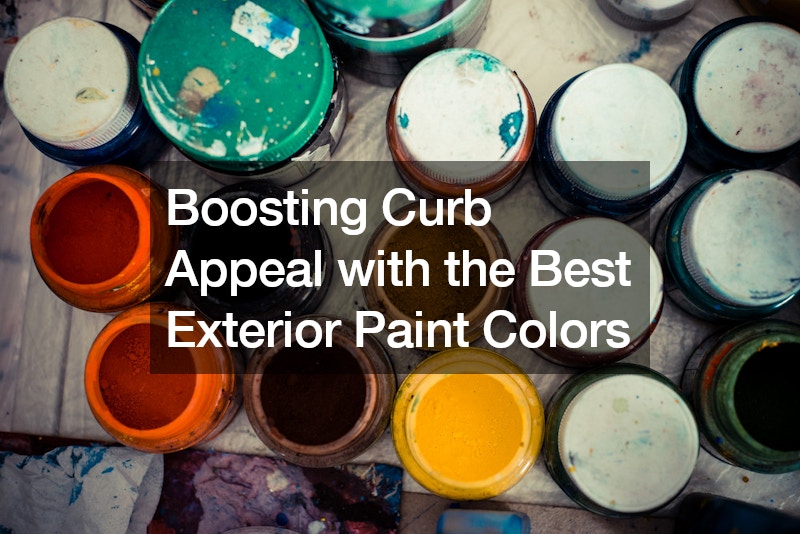Achieving a fresh, inviting exterior is key to enhancing your home’s curb appeal. Whether you’re planning a complete remodel or a simple update, choosing the right exterior paint colors can make a significant difference. In this article, we will explore the best exterior paint colors, coordinating trims, and front door accents to transform your home’s appearance.
Choosing Classic Whites
Classic whites are timeless and versatile, offering a crisp, clean look that can adapt to various lighting conditions. The key to selecting the perfect white lies in understanding its light reflectance value (LRV).
LRV measures how much light a color reflects, ranging from 0 to 100. Higher LRV numbers indicate lighter colors, while lower numbers correspond to darker hues. For exterior whites, look for shades with an LRV between 70 and 85 to ensure they maintain a bright yet subtle presence.
When selecting a white paint, consider the surrounding elements like the roof color, window trims, and natural landscape. These factors can influence how the white appears throughout the day. Sampling different shades by painting large swatches on your home’s exterior or using boards to compare colors in various lighting conditions can help you make an informed decision.
Embracing Off-Whites and Warm Neutrals
Off-whites and warm neutrals have become popular alternatives to stark minimalist whites. These shades offer a cozy and inviting feel, making your home appear welcoming from the outside in. Warm off-whites and neutrals typically have creamy undertones that can fluctuate between warm and cool, depending on the architectural features of your home. They pair beautifully with wood trims and stone facades, enhancing the natural elements of your exterior.
Cool whites, often featuring bluish-gray undertones, are commonly used in contemporary and modern settings. When choosing between warm and cool tones, it’s essential to maintain consistency. Mixing warm and cool tones can disrupt the overall aesthetic, so aim to keep them within the same color family.
Exploring Greens, Blues, and Grays
Nature-inspired colors like greens, blues, and grays have gained traction as popular choices for exterior painting. These shades offer a calm, organic look that complements natural surroundings. Variations of green, such as sage and olive, are particularly trendy, while blues and grays provide a touch of color without overwhelming the senses. These hues look stunning with wood details and earthy palettes, such as natural stone.
To create a cohesive look, start with a classic accent color like pure white or black, and add an unexpected touch, such as navy blue shutters against green siding or brick-colored window frames. This approach adds depth and character to your home’s exterior while maintaining a harmonious blend of colors.
Incorporating Moodier Hues
While classic whites and neutrals remain popular, darker, moodier hues are making a statement in exterior painting. These bold colors can add drama and sophistication to your home’s façade. When using darker shades like deep blues, blacks, and grays, it’s crucial to consider the amount of sunlight your home receives. Homes with more sun exposure can handle these colors better, as they prevent the exterior from appearing too dark and uninviting.
Pairing moodier hues with architectural features like stone siding or wooden terraces can balance the overall look, ensuring your home stands out without clashing with its surroundings. These combinations offer a bold yet elegant appearance that can significantly boost curb appeal.
Refreshing Your Front Door
A front door refresh is a simple yet effective way to update your home’s exterior without committing to a complete overhaul. Choosing a bold front door color can instantly elevate your curb appeal. Whether you prefer something bright and fun or quirky and full of personality, the front door is the perfect place to express your style.
Consider how the front door color complements the existing exterior paint. A contrasting color can make a striking statement, while a harmonious shade can create a cohesive look. The beauty of updating your front door color is that it’s an easy change to make whenever you want a new look, requiring minimal investment and effort.
Avoiding Common Paint Color Mistakes
Selecting the right paint color involves more than just choosing a shade that looks good on a sample. It’s important to consider how the color will appear on a larger scale and in different lighting conditions. For instance, yellow hues can sometimes appear sad and lackluster, while overly pigmented colors might look too intense during certain times of the day. Opting for warm off-whites or neutral tones can provide a balanced, inviting appearance.
When sampling colors, it’s advisable to paint large swatches on various sides of your home and observe how they look at different times of the day. This practice helps you avoid unexpected color changes and ensures you choose a hue that enhances your home’s architectural features.
Designer Tips for Exterior Painting
When choosing coordinating colors for shutters, trims, and siding, aim for high contrast to highlight your home’s details. Light and bright exterior colors can be paired with dark shutters and a bold front door for a striking effect. Additionally, timeless color palettes, such as classic whites and neutrals, never go out of style and can provide a lasting appeal.
To match a specific color seen in a picture or a neighbor’s house, use paint vendors’ color matching services. You can upload an image online, bring in a physical sample, or even use a piece of fabric or art for custom matching. Ensuring an exact match can help you achieve the desired look for your home.
Finally, always test samples before committing to a color. This step is crucial in finding the best exterior paint color that works harmoniously with your home’s existing features. Taking the time to research, sample, and compare colors will ensure your home’s exterior looks fresh, inviting, and perfectly suited to its environment.
By carefully selecting exterior paint colors and considering the impact of trims and front door accents, you can significantly boost your home’s curb appeal and create a welcoming, aesthetically pleasing exterior.
.












